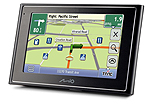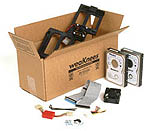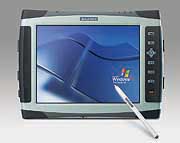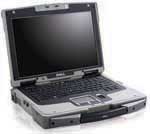March 2008
Palm Centro: A million sold
Palm has sold its one-millionth Palm Centro smartphone, demonstrating the $99 product's mass appeal. Compared to other Palm smartphones, the small and elegant Centro reaches almost double the number of women, more than double the number of customers under age 35, and nearly three times as many customers with a household income of less than $75,000. -- Posted Monday, March 31, 2008
The UMPC Evolution: Samsung’s Q1 Ultra
 We believe there is a place for the UMPC platform. And we are happy to see it maturing and expanding. Samsung, the first to enter the market with a UMPC a couple of years ago, has made another valiant entry with its second generation Q1 Ultra. The Q1 Ultra has a novel keyboard, higher res, a fingerprint scanner, two cameras, and a faster processor. Read Tim Hillebrand's impressions of the Samsung Q1 Ultra -- Posted Sunday, March 30, 2008
We believe there is a place for the UMPC platform. And we are happy to see it maturing and expanding. Samsung, the first to enter the market with a UMPC a couple of years ago, has made another valiant entry with its second generation Q1 Ultra. The Q1 Ultra has a novel keyboard, higher res, a fingerprint scanner, two cameras, and a faster processor. Read Tim Hillebrand's impressions of the Samsung Q1 Ultra -- Posted Sunday, March 30, 2008
Mio introduces four new GPS devices
 Using expertise from recently acquired Navman, Mio Technology created four new small GPS systems with 3.5-inch (320 x 240 pixels) or 4.3-inch wide-format (480 X 272 pixels) anti-glare touchscreens. The Mio Moov 200, 210, 300, and 310 all use a 20-channel SiRFstarIII receiver for fast signal lock, text-to-speech voice guidance, and more than 3.5 million points of interest. The Moov 210 and 310 come with a one-year paid Traffic Messaging Channel (TMC) subscription that provides real-time updates on accidents, detours and construction along with suggestions for alternate routes. The new devices list between US$179 and US$249. [See release on the new Mio Moov GPS devices] -- Posted Monday, March 24, 2008
Using expertise from recently acquired Navman, Mio Technology created four new small GPS systems with 3.5-inch (320 x 240 pixels) or 4.3-inch wide-format (480 X 272 pixels) anti-glare touchscreens. The Mio Moov 200, 210, 300, and 310 all use a 20-channel SiRFstarIII receiver for fast signal lock, text-to-speech voice guidance, and more than 3.5 million points of interest. The Moov 210 and 310 come with a one-year paid Traffic Messaging Channel (TMC) subscription that provides real-time updates on accidents, detours and construction along with suggestions for alternate routes. The new devices list between US$179 and US$249. [See release on the new Mio Moov GPS devices] -- Posted Monday, March 24, 2008
SMS-Chat Revisited
When we first tried SMS-Chat we were enthusiastic about it because it was fun, flashy, and new. We also liked the finger scrollable screens. But, after having used it now for a while, our Tim Hillebrand is developing a wish list for the next version of this Windows Mobile SMS messenger that organizes your SMS correspondence into threaded SMS conversations. [Read SMS-Chat Revisited] -- Posted Monday, March 24, 2008
Unitech lineup of durable and rugged data collection PDAs and terminals

We've added the Unitech lineup of durable and rugged point-of-sale and data collection handhelds. Unitech, a Taiwanese company, has almost 30 years of experience in data collection handhelds with integrated laser scanners, imagers, and RFID readers. Read description and full specs of the enterprise PDA Unitech PA500, the somewhat more rugged Unitech PA600, the rugged Unitech PA966/967 with a 36-key keyboard, the very rugged Unitech PA982 that can handle extreme temperatures and full immersion, and RFID reader Unitech RH767. All unit's are Windows Mobile or Windows CE-based. -- Posted Saturday, March 22, 2008
New Life For Your Old Tivo: Drive Upgrades & the Logitech Harmony One
 It's not always about mobile. What do you do when your TiVo goes south? David MacNeill describes his experience rebuilding his five-year-old Sony SVR-3000 TiVo with kits from DVRUpgrade.com and Weaknees.com, both experienced and well-established operations. Another item that was due for replacement was the TiVo's tired old remote control. Dave reviewed the Logitech Harmony One and can't say enough good things about it. [Read New Life For Your Old TiVo] -- Posted Friday, March 21, 2008
It's not always about mobile. What do you do when your TiVo goes south? David MacNeill describes his experience rebuilding his five-year-old Sony SVR-3000 TiVo with kits from DVRUpgrade.com and Weaknees.com, both experienced and well-established operations. Another item that was due for replacement was the TiVo's tired old remote control. Dave reviewed the Logitech Harmony One and can't say enough good things about it. [Read New Life For Your Old TiVo] -- Posted Friday, March 21, 2008
Advantech introduces semi-rugged industrial tablet
 Taiwanese Advantech, a global vendor of embedded and industrial computing platforms, introduced the MARS-3100S Industrial Tablet PC. The 3100S has a 10.4-inch display and runs XP Pro or XP Embedded on a power-efficient AMD LX 800 processor. With a magnesium-alloy housing and rubber bumpers the 3100S can survive 3-foot drops. IP54 sealing and the usual MIL-STD-810F testing compliance make this new Advantech product suitable for use in manufacturing, warehousing, shop floor maintenance, field service, transportation, law enforcement, fire or other emergency services. [See description and specs of the Advantech MARS-3100S tablet] -- Posted Wednesday, March 19, 2008
Taiwanese Advantech, a global vendor of embedded and industrial computing platforms, introduced the MARS-3100S Industrial Tablet PC. The 3100S has a 10.4-inch display and runs XP Pro or XP Embedded on a power-efficient AMD LX 800 processor. With a magnesium-alloy housing and rubber bumpers the 3100S can survive 3-foot drops. IP54 sealing and the usual MIL-STD-810F testing compliance make this new Advantech product suitable for use in manufacturing, warehousing, shop floor maintenance, field service, transportation, law enforcement, fire or other emergency services. [See description and specs of the Advantech MARS-3100S tablet] -- Posted Wednesday, March 19, 2008
ActiveCaptain Mobile for Palm OS
ActiveCaptain Mobile is a fully integrated boat navigation system for the Palm OS. Users can display real nautical charts, plan and navigate routes, and overlay points of interest from the ActiveCaptain website. It's three applications in one -- a chart archive, a portable chartplotter, and an electronic guidebook. With thousands of NOAA charts free of charge and always available, it makes a Palm Treo a critical part of being on the water. [See ActiveCaptain Mobile for Palm OS release] -- Posted Tuesday, March 18, 2008
To Flash or not to Flash
After reading a rather compelling explanation on why Apple chooses not to use Flash on the iPhone, we see that Microsoft apparently licensed Adobe Flash Lite for Windows Mobile. So Apple thinks Flash is too big, clumsy and proprietary to run on its powerful iPhone Safari browser, but Flash Lite should be satisfactory on mobile Internet Explorer? -- Posted Tuesday, March 18, 2008
SPB Plus or Shell: that is the question
Spb Software has two excellent Today screen launcher type programs with a great deal of overlap. Which should you choose to enhance your pocket pal? [Read Tim's thoughts on SPB Software's launcher programs] -- Posted Tuesday, March 18, 2008
AstroNavigator v2.01
What I would have given for AstroNavigator when I was earning my Boy Scout Astronomy Merit Badge. With Astronavigator on board and hooked up to a satellite feed, you just face in any direction, and a picture of the heavens will appear on your screen. [Read Tim's review of AstroNavigator v2.01] -- Posted Monday, March 17, 2008
SPB Weather Release 1.7.4
Spb Weather is clearly one of the top weather programs available for Windows Mobile devices. If you are already a user, you will want to take advantage of this free upgrade. Otherwise, you may wish to check it out and add it to your bag of tricks. [Read review of SPB Weather 1.7.4] -- Posted Friday, March 14, 2008
Added: Gateway C-141
The Gateway C-Series Tablet PC convertible (now called an "adaptable notebook") goes on with the C-141 models, following up on the CX200 Series introduced in October of 2005 and the company's initial M275 Tablet PC convertible. [See description and specs of the Gateway C-141 Tablet PC convertible] -- Posted Monday, March 10, 2008
Review: SPB Mobile Shell 2.0
There’s a whole host of new features in the latest release of SPB Mobile Shell. It seemed to me that it hasn’t been that long since it first appeared on my Windows Mobile screen, but I guess it was actually a year ago this month. How time flies when you’re having fun with your pocket pals. [Read review of SPB Mobile Shell 2.0] -- Posted Monday, March 10, 2008
Dual personality rugged military smartphone
 Though it looks a bit like it, the Sectéra Edge by General Dynamics is not your average Blackberry clone. Instead, it is a SME-PED — a Secure Mobile Environment Portable Electronic Device. The Windows Mobile-based device was specifically developed for the National Security Agency's SME-PED program and is certified by the NSA. It's fully rugged and can be operated both in classified and unclassified mode. [See description and specs of the General Dynamics Sectéra Edge] -- Posted Thursday, March 6, 2008
Though it looks a bit like it, the Sectéra Edge by General Dynamics is not your average Blackberry clone. Instead, it is a SME-PED — a Secure Mobile Environment Portable Electronic Device. The Windows Mobile-based device was specifically developed for the National Security Agency's SME-PED program and is certified by the NSA. It's fully rugged and can be operated both in classified and unclassified mode. [See description and specs of the General Dynamics Sectéra Edge] -- Posted Thursday, March 6, 2008
DRS Tactical lunches ARMOR line of rugged computers
DRS Tactical, located in Melbourne, Florida, announced ARMOR, a line of rugged mobile computers with an emphasis on data protection technology, anywhere connectivity and sunlight readable display options for industrial and government customers. The initial products of the ARMOR line include the compact C12 notebook convertible and the X10 Tablet, a 9th generation Hammerhead. -- Posted Thursday, March 6, 2008
PCMCIA announces ExpressCard 2.0
Times have changed since early Pen Computing contributor Bill Lempesis was executive director of PCMCIA but the PC Card standard is alive and well. PCMCIA also addresses the future with the ExpressCard standard which just received another big boost with the announcement of ExpressCard Standard 2.0 that supports transfer rates up to 5Gbps, twice as fast as the current ExpressCard Standard 1.2. Version 2.0 also supports the upcoming "SuperSpeed" USB 3.0 spec, potentially making ExpressCard 2.0 ten times faster than the current spec. -- Posted Wednesday, March 5, 2008
Dell introduces rugged Latitude XFR D630
 Dell is getting serious about rugged notebooks. The XFR D630 is a heavily ruggedized version of the Latitude 630 platform. As such it fits right into the IT infrastructure of numerous organizations that already have hundreds or thousands of Dell Latitudes. But the XFR D630 can more than hold its own with up-to-date technology, excellent connectivity, numerous wireless options, Dell's superb DirectVue sunlight-viewable display technology and impressive ruggedness specs: IP54 sealing, multiple 3-foot drops, operating temperature between -20 and 140 degrees, solid state disk options, a touch screen option, and a competitive price. [Read description and specs of the Dell Latitude XFR D630] -- Posted Tuesday, March 4, 2008
Dell is getting serious about rugged notebooks. The XFR D630 is a heavily ruggedized version of the Latitude 630 platform. As such it fits right into the IT infrastructure of numerous organizations that already have hundreds or thousands of Dell Latitudes. But the XFR D630 can more than hold its own with up-to-date technology, excellent connectivity, numerous wireless options, Dell's superb DirectVue sunlight-viewable display technology and impressive ruggedness specs: IP54 sealing, multiple 3-foot drops, operating temperature between -20 and 140 degrees, solid state disk options, a touch screen option, and a competitive price. [Read description and specs of the Dell Latitude XFR D630] -- Posted Tuesday, March 4, 2008
MobileDemand announces production availability of rugged xTablet T8700
MobileDemand announced full production availability of the xTablet T8700, the latest installment in their roster of rugged computer solutions built for a variety of vertical markets. The xTablet T8700, equipped with a data entry keypad and available with scanner and mag card reader options, is ideal for mobile workforces with its unique combination of Intel Core Duo performance, extensive data collection capabilities, and military rated ruggedness. The T8700 is also one of the few rugged tablets we've seen supporting Windows Vista (we published the test scores). See the videos for an amazing demonstration of the unit's ruggedness! [Read full press release] [Read our full review of the xTablet T8700] -- Posted Monday, March 3, 2008
What role will Intel's new Atom processor play?
 Intel introduced the low-power Atom processor designed specifically for mobile internet devices. While desktop chips draw as much as 35 watts of thermal design power (TDP) and even ultra-low power Core Duos draw almost 10 watts, the Atoms will draw from 0.6 to 2.5 watts. Intel stresses that the chip is not a shrunken version of a desktop chip, but designed from the ground up. Various Intel sources mentioned its use as in $250-400 notebooks, "Intel's architecture for mobile devices," "devices that fit in pockets," and as "the basis of new sexy: low power and small." And no fan needed. Will Atom replace the ARM-based PXA processors that Intel jettisoned to Marvell? [See our take on Intel's new Atom processor] -- Posted Monday, March 3, 2008
Intel introduced the low-power Atom processor designed specifically for mobile internet devices. While desktop chips draw as much as 35 watts of thermal design power (TDP) and even ultra-low power Core Duos draw almost 10 watts, the Atoms will draw from 0.6 to 2.5 watts. Intel stresses that the chip is not a shrunken version of a desktop chip, but designed from the ground up. Various Intel sources mentioned its use as in $250-400 notebooks, "Intel's architecture for mobile devices," "devices that fit in pockets," and as "the basis of new sexy: low power and small." And no fan needed. Will Atom replace the ARM-based PXA processors that Intel jettisoned to Marvell? [See our take on Intel's new Atom processor] -- Posted Monday, March 3, 2008
 We believe there is a place for the UMPC platform. And we are happy to see it maturing and expanding. Samsung, the first to enter the market with a UMPC a couple of years ago, has made another valiant entry with its second generation Q1 Ultra. The Q1 Ultra has a novel keyboard, higher res, a fingerprint scanner, two cameras, and a faster processor. Read Tim Hillebrand's impressions of the Samsung Q1 Ultra -- Posted Sunday, March 30, 2008
We believe there is a place for the UMPC platform. And we are happy to see it maturing and expanding. Samsung, the first to enter the market with a UMPC a couple of years ago, has made another valiant entry with its second generation Q1 Ultra. The Q1 Ultra has a novel keyboard, higher res, a fingerprint scanner, two cameras, and a faster processor. Read Tim Hillebrand's impressions of the Samsung Q1 Ultra -- Posted Sunday, March 30, 2008 Using expertise from recently acquired Navman, Mio Technology created four new small GPS systems with 3.5-inch (320 x 240 pixels) or 4.3-inch wide-format (480 X 272 pixels) anti-glare touchscreens. The Mio Moov 200, 210, 300, and 310 all use a 20-channel SiRFstarIII receiver for fast signal lock, text-to-speech voice guidance, and more than 3.5 million points of interest. The Moov 210 and 310 come with a one-year paid Traffic Messaging Channel (TMC) subscription that provides real-time updates on accidents, detours and construction along with suggestions for alternate routes. The new devices list between US$179 and US$249. [See
Using expertise from recently acquired Navman, Mio Technology created four new small GPS systems with 3.5-inch (320 x 240 pixels) or 4.3-inch wide-format (480 X 272 pixels) anti-glare touchscreens. The Mio Moov 200, 210, 300, and 310 all use a 20-channel SiRFstarIII receiver for fast signal lock, text-to-speech voice guidance, and more than 3.5 million points of interest. The Moov 210 and 310 come with a one-year paid Traffic Messaging Channel (TMC) subscription that provides real-time updates on accidents, detours and construction along with suggestions for alternate routes. The new devices list between US$179 and US$249. [See 
 It's not always about mobile. What do you do when your TiVo goes south? David MacNeill describes his experience rebuilding his five-year-old Sony SVR-3000 TiVo with kits from DVRUpgrade.com and Weaknees.com, both experienced and well-established operations. Another item that was due for replacement was the TiVo's tired old remote control. Dave reviewed the Logitech Harmony One and can't say enough good things about it. [Read
It's not always about mobile. What do you do when your TiVo goes south? David MacNeill describes his experience rebuilding his five-year-old Sony SVR-3000 TiVo with kits from DVRUpgrade.com and Weaknees.com, both experienced and well-established operations. Another item that was due for replacement was the TiVo's tired old remote control. Dave reviewed the Logitech Harmony One and can't say enough good things about it. [Read  Taiwanese Advantech, a global vendor of embedded and industrial computing platforms, introduced the MARS-3100S Industrial Tablet PC. The 3100S has a 10.4-inch display and runs XP Pro or XP Embedded on a power-efficient AMD LX 800 processor. With a magnesium-alloy housing and rubber bumpers the 3100S can survive 3-foot drops. IP54 sealing and the usual MIL-STD-810F testing compliance make this new Advantech product suitable for use in manufacturing, warehousing, shop floor maintenance, field service, transportation, law enforcement, fire or other emergency services. [See description and specs of the
Taiwanese Advantech, a global vendor of embedded and industrial computing platforms, introduced the MARS-3100S Industrial Tablet PC. The 3100S has a 10.4-inch display and runs XP Pro or XP Embedded on a power-efficient AMD LX 800 processor. With a magnesium-alloy housing and rubber bumpers the 3100S can survive 3-foot drops. IP54 sealing and the usual MIL-STD-810F testing compliance make this new Advantech product suitable for use in manufacturing, warehousing, shop floor maintenance, field service, transportation, law enforcement, fire or other emergency services. [See description and specs of the  Though it looks a bit like it, the Sectéra Edge by General Dynamics is not your average Blackberry clone. Instead, it is a SME-PED — a Secure Mobile Environment Portable Electronic Device. The Windows Mobile-based device was specifically developed for the National Security Agency's SME-PED program and is certified by the NSA. It's fully rugged and can be operated both in classified and unclassified mode. [See description and specs of the
Though it looks a bit like it, the Sectéra Edge by General Dynamics is not your average Blackberry clone. Instead, it is a SME-PED — a Secure Mobile Environment Portable Electronic Device. The Windows Mobile-based device was specifically developed for the National Security Agency's SME-PED program and is certified by the NSA. It's fully rugged and can be operated both in classified and unclassified mode. [See description and specs of the  Dell is getting serious about rugged notebooks. The XFR D630 is a heavily ruggedized version of the Latitude 630 platform. As such it fits right into the IT infrastructure of numerous organizations that already have hundreds or thousands of Dell Latitudes. But the XFR D630 can more than hold its own with up-to-date technology, excellent connectivity, numerous wireless options, Dell's superb DirectVue sunlight-viewable display technology and impressive ruggedness specs: IP54 sealing, multiple 3-foot drops, operating temperature between -20 and 140 degrees, solid state disk options, a touch screen option, and a competitive price. [Read description and specs of the
Dell is getting serious about rugged notebooks. The XFR D630 is a heavily ruggedized version of the Latitude 630 platform. As such it fits right into the IT infrastructure of numerous organizations that already have hundreds or thousands of Dell Latitudes. But the XFR D630 can more than hold its own with up-to-date technology, excellent connectivity, numerous wireless options, Dell's superb DirectVue sunlight-viewable display technology and impressive ruggedness specs: IP54 sealing, multiple 3-foot drops, operating temperature between -20 and 140 degrees, solid state disk options, a touch screen option, and a competitive price. [Read description and specs of the  Intel introduced the low-power Atom processor designed specifically for mobile internet devices. While desktop chips draw as much as 35 watts of thermal design power (TDP) and even ultra-low power Core Duos draw almost 10 watts, the Atoms will draw from 0.6 to 2.5 watts. Intel stresses that the chip is not a shrunken version of a desktop chip, but designed from the ground up. Various Intel sources mentioned its use as in $250-400 notebooks, "Intel's architecture for mobile devices," "devices that fit in pockets," and as "the basis of new sexy: low power and small." And no fan needed. Will Atom replace the ARM-based PXA processors that Intel jettisoned to Marvell? [See our take on
Intel introduced the low-power Atom processor designed specifically for mobile internet devices. While desktop chips draw as much as 35 watts of thermal design power (TDP) and even ultra-low power Core Duos draw almost 10 watts, the Atoms will draw from 0.6 to 2.5 watts. Intel stresses that the chip is not a shrunken version of a desktop chip, but designed from the ground up. Various Intel sources mentioned its use as in $250-400 notebooks, "Intel's architecture for mobile devices," "devices that fit in pockets," and as "the basis of new sexy: low power and small." And no fan needed. Will Atom replace the ARM-based PXA processors that Intel jettisoned to Marvell? [See our take on